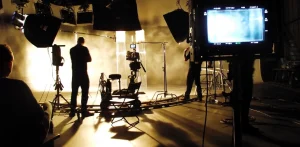Portrait of God isn’t the kind of horror that scares you with ghosts—it’s the kind that creeps in when you start questioning the beliefs you’ve held onto your whole life. This short horror film, just seven minutes long—directed by Dylan Clark and released in 2022—doesn’t rely on classic jump scares or spooky effects. Instead, it takes place in a dark room with nothing but a painting lit by a projector and a woman staring at it. A painting that slowly shakes her faith, rattles her logic, and fills her heart with doubt.
Despite its short runtime, Portrait of God has caught attention for its unique approach to spiritual themes within psychological horror. It’s not a typical horror flick where something jumps out every minute. This one forces you to sit still, reflect, and feel disturbed in a strangely intimate way. It even received a 7.4/10 rating from over two thousand viewers on IMDb. Here’s why it deserves a spot on your horror watchlist.
A Blank Painting That Fills the Mind
The film follows Mia Reilly, a young religious woman. The title comes from the painting she’s researching for her academic presentation—Portrait of God. While most people see it as a blank canvas, a few claim to see a mysterious figure hidden inside. Hoping to deepen her spiritual connection, Mia stares at the painting with growing intensity. But instead of feeling peace or closeness to God, she becomes overwhelmed, frightened, and mentally shaken.
You’re drawn into Mia’s emotional spiral as her spiritual journey doesn’t bring comfort but instead dismantles her faith. The film masterfully expresses the complex emotions of a person seeking closeness to God, only to find themselves lost in something terrifying. Through Mia, we feel the tension between faith, perception, and doubt. What’s powerful is how the film shows her belief system breaking down—not through arguments or dogma, but through an eerie, mystical experience that defies logic.
Chills Without Jumpscares
What stands out most is how Dylan Clark builds fear through simplicity. There’s no loud music or sudden ghostly appearances. Instead, the horror unfolds in a minimalistic setting—a dark room, a single light from a projector, and silence. Imagine watching a woman sit alone in that space, barely moving, with only a dim glow reflecting on the painting. It creates a suffocating, eerie mood that sticks with you.
The tight, off-center camera angles make you feel trapped in that room with Mia. It’s uncomfortable, claustrophobic, and mirrors her disoriented, unstable state of mind. In an interview, Clark mentioned he wanted to create tension through a small, dark space—and play with the idea that not everyone can see the “figure” in the painting. As a viewer, you start questioning yourself: “Did I really see that, or was it just in my head?” That blend of fear and uncertainty is what makes the psychological horror hit hard.
A Spiritual Journey That Takes Peace Away
Portrait of God doesn’t just scare through visuals—it hits conceptually, too. It pushes you to rethink how we see and imagine God. Usually, we associate God with light, love, and comfort. But this film flips that image. It suggests that encountering the divine might not be peaceful—it might be terrifying and deeply alien.
In the film, God isn’t portrayed as a loving or peaceful figure, but more like a presence beyond human understanding—one that breaks logic and warps reality. One viewer even commented, “The god-touched, holy, prophets should be horrifying.” And it makes sense. In many religious stories, those who were directly touched by the divine didn’t find peace—they found fear, suffering, and even trauma.
This film reminds us that faith is deeply personal, and when it’s tested by things we can’t explain, the experience can be deeply unsettling. Portrait of God shows that horror can lie not just in the unknown, but in the shattering of something we once believed to be true.
Horror That Awakens Spirituality
All in all, Portrait of God proves that horror films don’t always need ghosts, blood, or loud scares to be effective. In just seven minutes, it shows how horror can dive into deeper themes—faith, spirituality, and the quiet fears that live inside us. The story and characters are strong, the visuals simple, yet the emotional impact is huge. No jumpscares needed.
This film is perfect for horror fans looking for something different—something that lingers. If you enjoy reflecting on the meaning of faith, truth, or reality itself, Portrait of God is a must-watch. Because sometimes, the scariest things aren’t what go bump in the night—but what quietly shatter everything we thought we believed.
Read more horror film reviews here.




